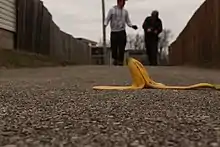香蕉皮
用途
一般人食用了香蕉後會直接丢弃香蕉皮[1][2]。 不過香蕉皮經過加工後可以成為牛、山羊、猪、猴子、家禽、兔子、鱼、斑马等動物的飼料。[3][4][5]
香蕉皮还可用于水净化、 生产乙醇[6]、 纤维素酶[7]、漆酶[8][9],香蕉皮也可以用作肥料[10]和堆肥。 [11]
其他
香蕉皮的摩擦力只有0.07,因此人們踩到香蕉皮後很有可能會滑倒。研究人员認為這是由於香蕉皮的多糖滤泡凝胶被踩碎後,會释放出溶胶,從而造成一定的危險。 [16]研究人員憑藉这一发现获得了2014年度的搞笑諾貝爾獎。[17]
参考文献
- Derived from: . Food and Agriculture Organization of the United Nations. [2022-07-13]. (原始内容存档于2013-04-01). The data for bananas and plantains for 2011 were combined as the two are distinguished by some countries but combined under "bananas" by others.
- G.M. Babatunde: Availability of banana and plantain products for animal feeding. In: D. Machin, S. Nyvold: Roots, tubers, plantains and bananas in animal feeding. Proceedings of the FAO Expert Consultation held in CIAT, Cali, Colombia FAO ANIMAL PRODUCTION AND HEALTH PAPER 95, FAO, Rome, 1992.
- Heuzé V., Tran G., Archimède H., 25 March 2016. Banana peels. Feedipedia, a programme by INRA, CIRAD, AFZ and FAO. https://www.feedipedia.org/node/684 (页面存档备份,存于) Retrieved 24 August 2017.
- Happi Emaga, T. ; Bindelle, J. ; Agneesens, R. ; Buldgen, A. ; Wathelet, B. ; Paquot, M., 2011. Ripening influences banana and plantain peels composition and energy content. Trop. Anim. Health Prod., 43 (1): 171-177
- Onwuka, C. F. I. ; Adetiloye, P. O. ; Afolami, C. A., 1997. Use of household wastes and crop residues in small ruminant feeding in Nigeria. Small Rumin. Res., 24: 233-237
- A. Chaparadza, JM Hossenlopp: adsorption kinetics, isotherms and thermodynamics of atrazine removal using a banana peel based sorbent. Water Science Technology 65 (5), 2012, pp. 940-947
- HS Oberoi, PV Vadlani, L. Saida, S. Bansal, JD Hughes: ethanol production from banana peels using Statistically optimized simultaneous saccharification and fermentation process. Waste Management 31 (7), 2011, pp. 1576–1584
- V. Vivekanand, P. Dwivedi, N. Pareek, RP Singh: Banana peel: a potential substrates for laccase production by Aspergillus fumigatus VkJ2.4.5 in solid-state fermentation. Applied Biochemistry and Biotechnology 165 (1), 2011, pp. 204-20
- Hai-Yan Sun, Li Juanhua, Pingjuan Zhao, Ming Peng: Banana peel. A novel substrates for cellulase production under solid-state fermentation African Journal of Biotechnology 10 (77), 2011, pp. 1788
- . FrugalChicken. 5 July 2015 [6 July 2015]. (原始内容存档于2015-07-06).
- F. Kalemelawa, E. Nishihara, T. Endo, Z. Ahmad, R. Yeasmin, MM Tenywa, S. Yamamoto, "An evaluation of aerobic and anaerobic composting of banana peels treated with different inoculum for soil nutrient replenishment", Bioresource Technology 126, 2012 pp. 375-82
- Cash, Meredith. . Insider. 2019-03-29 [2021-02-03].
- Abernethy, Laura. . Metro. 2019-04-03 [2021-02-03]. (原始内容存档于2022-10-10) (英语).
- . Heart. 4 April 2020 [2021-02-02]. (原始内容存档于2022-10-25) (英语).
- Yeates, Cydney. . Metro. 2020-11-10 [2021-02-02]. (原始内容存档于2022-07-16) (英语).
- Kiyoshi Mabuchi; Kensei Tanaka; Daichi Uchijima; Rina Sakai. . Tribology Online. 2012, 7 (3): 147–151 [2022-07-13]. doi:10.2474/trol.7.147
 . (原始内容存档于2020-05-17).
. (原始内容存档于2020-05-17). - . August 2006 [2022-07-13]. (原始内容存档于2013-02-26).
This article is issued from Wikipedia. The text is licensed under Creative Commons - Attribution - Sharealike. Additional terms may apply for the media files.

.jpg.webp)
